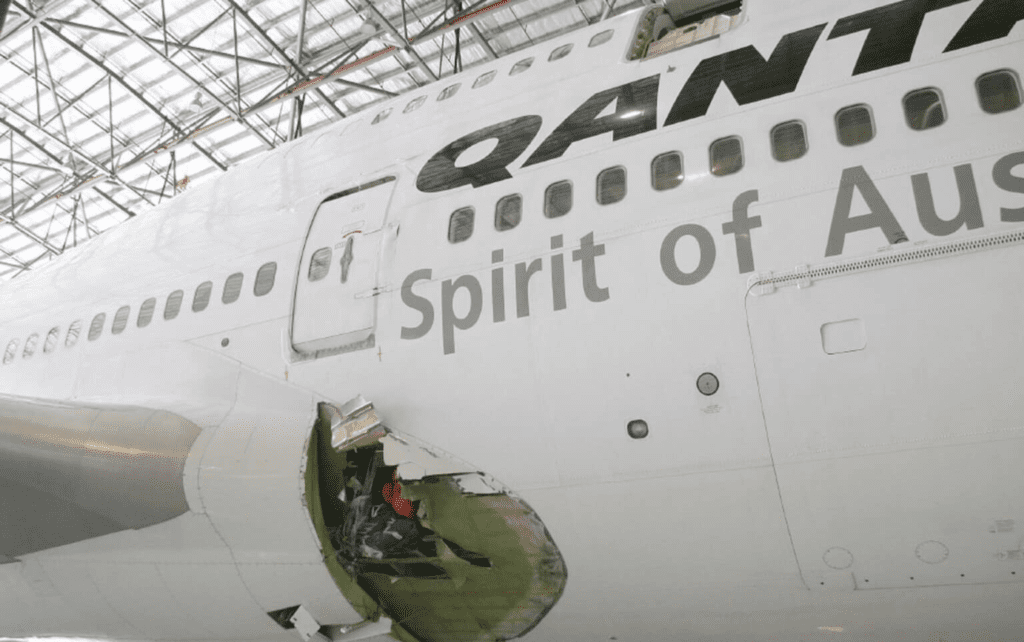
25 July 2008 15 years ago today. Boeing 747-438 operated by Qantas VH-OJK, was a scheduled flight QF30 from London Heathrow to Melbourne with a stopover in Hong Kong. At 1017 (0217 UTC), the captain and first officer reported hearing a ‘loud bang or cracking sound’, with an associated airframe jolt. At that time, the autopilot disconnected and the first officer, who was the pilot flying at the time, assumed manual control of the aircraft. Multiple EICAS messages were displayed, including warnings regarding the R2 door status and cabin altitude .

The second officer, who was in the forward crew rest position, returned to the first observer’s crew seat and all flight crew donned oxygen masks before completing the ‘cabin altitude non normal’ checklist. At that time, the aircraft was approximately 475 km to the northwest of Manila, Philippines.The cabin crew reported that shortly after the bang was heard, oxygen masks fell from most of the personal service units in the ceiling above passenger seats and in the toilets.
Most passengers started using the oxygen masks soon after they dropped. All cabin crew, who were engaged in passenger service activities at the time, immediately located oxygen masks to use. Some crew located a spare passenger mask and sat in between passengers, while others went to a crew jump seat at an exit, and one used a mask in a toilet. Approximately 20 seconds after the event, the flight crew reduced the thrust on all four engines and extended the speed brakes.
An emergency descent was commenced and a MAYDAY declared on the Manila flight information region (FIR) radio frequency At 1024 (0224 UTC), the aircraft reached, and was levelled at an altitude of 10,000 ft, where the use of supplementary oxygen by passengers and crew was no longer required. After reviewing the aircraft’s position, the flight crew elected to divert to Ninoy Aquino International Airport, Manila. As part of the landing preparations, excess fuel was jettisoned to ensure the aircraft landing weight was within safe limits.
The flight crew reported that many system failure messages were displayed, including all three instrument landing systems (ILS), the left very high frequency (VHF) omnidirectional radio-range (VOR) navigation instrument, the left flight management computer (FMC) and the aircraft anti-skid braking system. The QANTAS flight QF30 crew reported that at all times during the ensuing descent into Manila, they were able to maintain the aircraft in visual flight conditions.
Following radar vectoring from Manila air traffic control, the captain, who had assumed the pilot flying role, conducted an uneventful approach and landing on runway 06, with a smooth touchdown, full reverse thrust and minimal braking. Emergency services were in attendance after the aircraft was stopped on the runway, after which intercom contact was made with a ground engineer and the aircraft verified as being safe to tow to the airport terminal and disembark the passengers via a terminal air-bridge.The fuselage rupture produced by the bursting oxygen cylinder encompassed an area of approximately 1.74 m2 ; centred on fuselage body station 820 (BS 820) and coinciding with the right wing leading edge root fairing.
A total of five adjacent longitudinal stringers (32 to 36) and two adjacent circumferential frames (800 and 820) had been structurally compromised during the fuselage rupture event. The physical damage sustained was entirely consistent with a localized, outward forcing explosive event, with all fracture surfaces examined showing typical ductile tearing and tensile overstress features. An outward and upward folded flap of fuselage skin at the top of the ruptured area and encompassing fuselage stringers 32 and 33, showed clear outward bulging and deformation – that skin had been located immediately behind the lower part of the number 4 passenger oxygen cylinder.
Repairs to the aircraft were conducted in Manila by Boeing. It was ferried to Avalon on 10 November 2008. The original captain and first officer were part of the ferry crew. The only work that remained to be done at that point was the replacement of the carpets and seat covers. On 18 November 2008, with all work complete, the aircraft was damaged again when another Qantas Boeing 747 collided with it at Avalon. The aircraft was eventually returned to service on 15 January 2009 but retired from service at the end of 2009 and sold to Nigerian carrier Max Air in 2011, re-registered as 5N-HMB. The aircraft was then operated for a further six years before being stored at Pinal Airpark.
Source – Airline Secret Exposed Facebook Page





